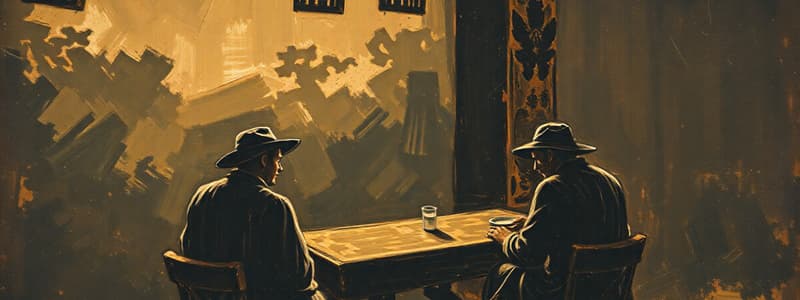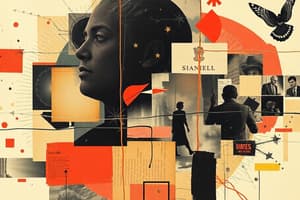Podcast
Questions and Answers
What is a primary component of organization theory?
What is a primary component of organization theory?
- Division of labor (correct)
- Exclusively management skills
- Financial analysis
- Emotional intelligence
Which concept emphasizes the use of diverse theoretical perspectives?
Which concept emphasizes the use of diverse theoretical perspectives?
- Theoretical pluralism (correct)
- Unified theory
- Theoretical identity
- Theoretical rigidity
Which function of organization is often overlooked?
Which function of organization is often overlooked?
- Flexibility
- Control (correct)
- Innovation
- Collaboration
What does the notion of critical thinking encourage in an individual?
What does the notion of critical thinking encourage in an individual?
How does organization theory benefit research?
How does organization theory benefit research?
What can result if an organization reacts to every situation?
What can result if an organization reacts to every situation?
What is one primary benefit derived from theoretical pluralism?
What is one primary benefit derived from theoretical pluralism?
Which type of critical thinking stresses the importance of self-criticism?
Which type of critical thinking stresses the importance of self-criticism?
What is a key factor in determining whether to formalize and establish a hierarchy in an organization?
What is a key factor in determining whether to formalize and establish a hierarchy in an organization?
In a matrix organization, how is labor typically divided?
In a matrix organization, how is labor typically divided?
What implication does a decrease in the number of middle managers have on an organization?
What implication does a decrease in the number of middle managers have on an organization?
What is suggested about the relationship between IT and organizational structure?
What is suggested about the relationship between IT and organizational structure?
How should an organization approach its structural configuration according to the content?
How should an organization approach its structural configuration according to the content?
Which of the following is NOT a characteristic of low-end activities in an organization?
Which of the following is NOT a characteristic of low-end activities in an organization?
What is a potential consequence of introducing formalization in an organization?
What is a potential consequence of introducing formalization in an organization?
What aspect of organizational decision-making can IT enhance according to the content?
What aspect of organizational decision-making can IT enhance according to the content?
What is the ideal competence strategy according to the HR framework?
What is the ideal competence strategy according to the HR framework?
According to the HR framework, what should take precedence if possible?
According to the HR framework, what should take precedence if possible?
Which of the following reflects the fundamental assumptions of the Power Framework?
Which of the following reflects the fundamental assumptions of the Power Framework?
What is suggested about conflicts according to the Power Framework?
What is suggested about conflicts according to the Power Framework?
What does the Power Framework imply about organizational structures?
What does the Power Framework imply about organizational structures?
What can the visibility of a hidden conflict lead to, according to the Power Framework?
What can the visibility of a hidden conflict lead to, according to the Power Framework?
What aspect of stakeholder dynamics is emphasized in the Power Framework?
What aspect of stakeholder dynamics is emphasized in the Power Framework?
Who are some key thinkers referenced in the context of power and organizational theory?
Who are some key thinkers referenced in the context of power and organizational theory?
What criticism does the power framework have towards structural and HR frameworks regarding organizational activities?
What criticism does the power framework have towards structural and HR frameworks regarding organizational activities?
According to Lukes’ first dimension of power, how is power defined?
According to Lukes’ first dimension of power, how is power defined?
What does the power framework reveal about the representation of issues in organizational agendas?
What does the power framework reveal about the representation of issues in organizational agendas?
What is a key aspect that the power framework analyzes in organizational contexts?
What is a key aspect that the power framework analyzes in organizational contexts?
What is implied by the power framework about the composition of high management positions?
What is implied by the power framework about the composition of high management positions?
In the context of power dynamics, which of the following is a challenge when analyzing agendas?
In the context of power dynamics, which of the following is a challenge when analyzing agendas?
Why does the power framework emphasize the political processes within organizations?
Why does the power framework emphasize the political processes within organizations?
How does the power framework's view of organizations differ from more traditional views?
How does the power framework's view of organizations differ from more traditional views?
How does having a larger factual basis affect an organization's ability to attract resources?
How does having a larger factual basis affect an organization's ability to attract resources?
What is a risk associated with comprehensive rational decision-making processes?
What is a risk associated with comprehensive rational decision-making processes?
What role do middle managers play in the separation between decision-making and operational actions?
What role do middle managers play in the separation between decision-making and operational actions?
According to Brunsson's theory, how can the formulation of plans and goals impact implementation?
According to Brunsson's theory, how can the formulation of plans and goals impact implementation?
What is organizational hypocrisy in the context discussed?
What is organizational hypocrisy in the context discussed?
How might a goal of gender balance in management affect the implementation of concrete measures?
How might a goal of gender balance in management affect the implementation of concrete measures?
What consequence can arise from setting environmental goals in industrial contexts?
What consequence can arise from setting environmental goals in industrial contexts?
What might be a common effect of the separation between higher-level decision-making and lower-level operations?
What might be a common effect of the separation between higher-level decision-making and lower-level operations?
Flashcards are hidden until you start studying
Study Notes
Organization Theory
- Focuses on coordination of labor and the division of labor.
- Emphasizes critical thinking:
- Encourages moving beyond traditional thought processes
- Prioritizes interpreting new information
- Fosters creative thinking and action
- Theoretical Pluralism:
- Values different theoretical frameworks
- Emphasizes a comprehensive understanding by utilizing multiple perspectives
- Allows for analysis of interpretations in any subject
- Two Fundamental Functions:
- Provides analytical tools (models & concepts)
- Offers theoretical frameworks
Types of Critical Thinking
- Thinking Freely:
- Self-criticism is crucial for analysis of thought processes
- Flying and Maintaining Aircraft:
- Complexity of activities can be planned and structured using formalized processes
Environment and Strategy
- Environment: Includes factors such as laws, regulations, markets, and demographics
- Strategy: Involves decisions about resources, technology, and quality levels
Information Technology (IT)
- IT enables more centralized decision-making and vertical coordination.
- Can lead to an increase in IT departments or costs for external IT support.
- Increases the need for technostructure and support functions.
- Rationalizes organizational processes, potentially through decentralization and horizontal coordination or centralization and vertical control.
Labor Division and Matrix Organizations
- Matrix Organizations: Divide labor based on function and project.
- Examples: Development of a new product within a project group and the original department.
- Division of Labor:
- Divided across two or more principles (function, product etc).
Coordination and Control in Matrix Organizations
- Finding a balance between responsibilities and powers of the two dimensions is crucial.
- Combines the benefits of various labor division and coordination principles.
HR Framework
- Ideal Competence Strategy:
- Challenging Strategy: Prioritizes high-performance over specialization, standardization and vertical control.
- Competence Strategy: Takes precedence over business strategy.
- Focuses on maximizing employee investment and horizontal coordination.
- Contrasts with structural frameworks, providing a different approach to organizing.
Power Framework
- Focuses on stakeholder conflicts and power dynamics.
- Emphasizes that conflicts cannot be resolved by rational decisions but must be managed.
- Views organizational structures and processes as expressions of power and influence.
- Utilizes "The Art of War" and "The Prince" as historical examples.
Fundamental Assumptions
- Contradictory interests and goals drive constant conflict.
- Organizations cannot be designed to be universally effective, as achieving one stakeholder’s goal may not benefit others.
- Organizational structures reflect stakeholder power and influence.
- Conflicts are not always resolved, but managed.
Power Theories
- Power is most effective when concealed, appearing as shared goals and unity.
- Focuses on managing conflicts constructively and resolving conflicts through open power struggles.
Criticism of Other Frameworks
- Challenges the notion of organizational structures and processes as rational and scientific tools for universally benefiting everyone.
- Argues for understanding power and politics behind organizational structures.
Three Dimensions of Power
- Decision-making power: One individual has power over another to influence their actions.
- Power over the agenda: Controls which issues are considered and acted upon.
- Analyzing the agenda and identifying missing issues.
- Power over the mind/thought: Controls the perceptions, beliefs, and thinking processes of others, often through manipulating information.
Decision-Rational Talk and Action-Rational Processes
- Organization’s focus on decision-rational talk (planning, meetings, etc.) to attract resources.
- Emphasis on action-rational processes (implementing actions) to maintain legitimacy and achieve goals.
Decoupling Decision-Rational Talk from Action-Rational Action
- Separation between decision-making at higher levels and operational actions at lower levels.
- Focus on legitimacy and appearance for outsiders rather than implementing all strategies.
Organizational Hypocrisy
- Talk, decisions and actions may not be aligned.
- Formulating ethical guidelines that don't align with actions - hypocrisy.
- Setting goals can reduce the need for concrete measures to achieve those goals.
- Goals can act as buffers to reduce pressure for change.
Studying That Suits You
Use AI to generate personalized quizzes and flashcards to suit your learning preferences.




